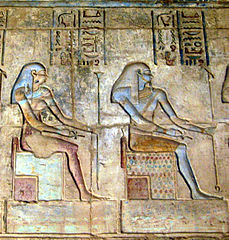
The Egyptian Shen-Ring,
symbol of all symbols,
represents the coming together
of the linear ordinary way of being
and the global plenary one
– in two words: time and eternity.
The art of passing from the one to the other,
and linking them at will,
is the secret of all dynamism and freedom.— Medhananda
The shen ring is at first glance a circle with a horizontal line in a tangent along its bottom edge. However the shen is more than meets the eye. The Shen is a symbol which represents eternity. The more elongated version is known as a “Shenu”. It is used to house the name of someone in Mtu Ntr or hieroglyphics. Once a name was placed within it, it was thought to protect that person from negativity.
Deriving its name from the root shenu (to encircle), it was almost always a symbol of eternity. However, the shen ring also held the idea of “protection.” It most often carried this connotation when seen in its elongated variation, the cartouche; which surrounded the birth and throne names of the Pharaohs. Continue reading
 THE RELIGION OF ANCIENT EGYPT
THE RELIGION OF ANCIENT EGYPT THE RELIGION OF ANCIENT EGYPT
THE RELIGION OF ANCIENT EGYPT Heh and Hauhet, Deities of Infinity and Eternity
Heh and Hauhet, Deities of Infinity and Eternity


 Top 20 Arithmetic Progression of Primes
Top 20 Arithmetic Progression of Primes
 Who Was the Teacher of Righteousness in the Dead Sea Scrolls?
Who Was the Teacher of Righteousness in the Dead Sea Scrolls?
 Habakkuk ►
Habakkuk ►










Recent Comments